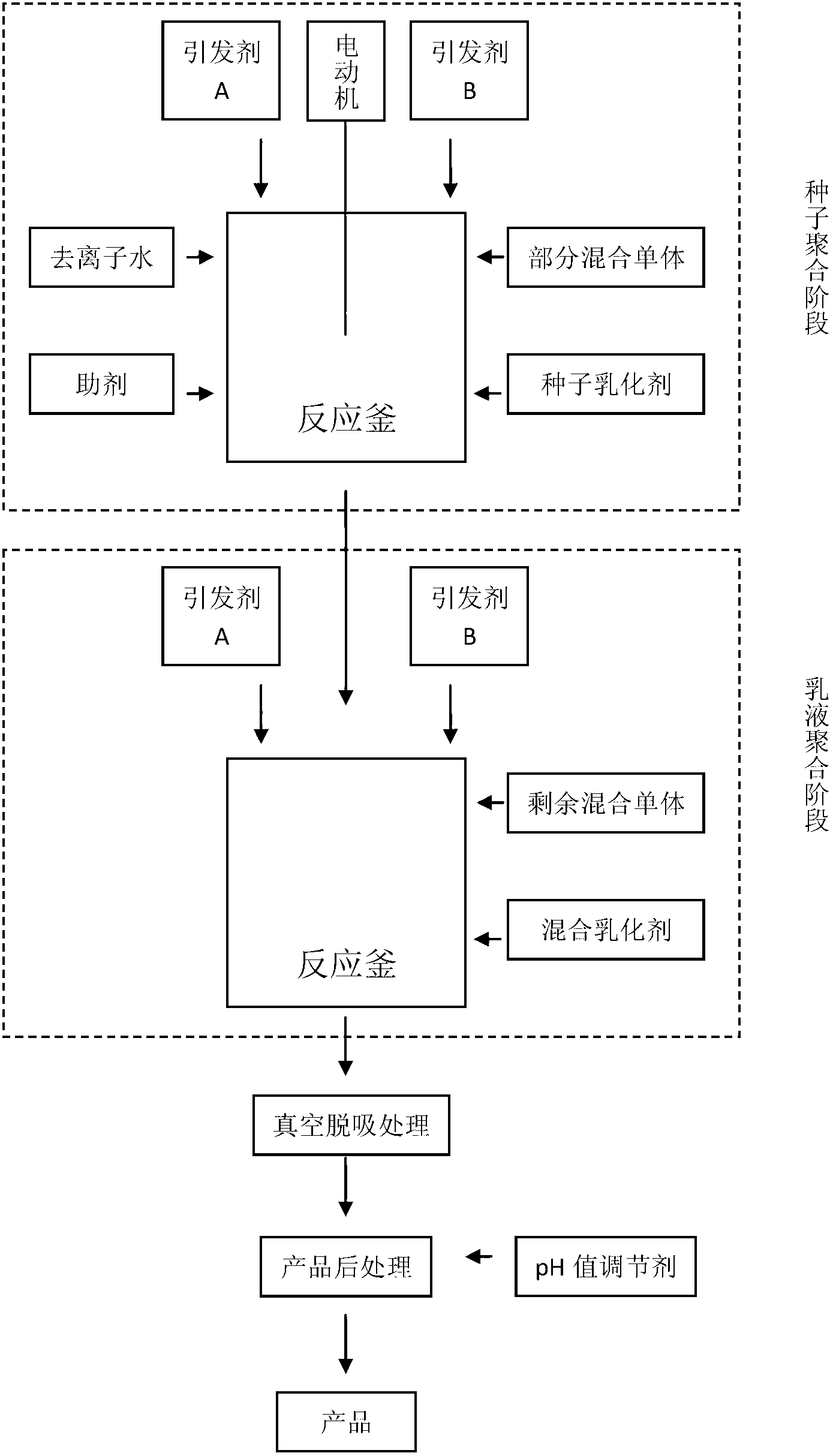Polyvinylidene chloride copolymer emulsion for pharmaceutical packing coating and preparation method and application thereof
A polyvinylidene chloride and copolymer emulsion technology, which is applied in the field of polyvinylidene chloride copolymer emulsion, can solve problems such as insufficient emulsion stability, emulsion stability defects, and insufficient emulsion stability, achieving low cost and excellent flexibility , The effect of eliminating foam
- Summary
- Abstract
- Description
- Claims
- Application Information
AI Technical Summary
Problems solved by technology
Method used
Image
Examples
Embodiment 1
[0051] 1. Raw material preparation: mix 90kg of vinylidene chloride, 5kg of 2-ethylhexyl acrylate, 4.5kg of methyl methacrylate, and 0.5kg of methacrylic acid, and stir for 2 hours to make a mixed monomer; mix tert-butyl Add 160 g of hydrogen peroxide into 8 kg of deionized water and stir and mix to make a tert-butyl hydroperoxide solution; add 160 g of sodium formaldehyde sulfoxylate to 8 kg of deionized water and stir and mix to make a solution of sodium formaldehyde sulfoxylate; Add 600g of sodium dodecylsulfonate and 600g of sodium dodecylbenzenesulfonate into water and mix, add deionized water to 20kg and carry out cold dispersion for 2 hours to make a mixed emulsifier solution;
[0052]2. Seed polymerization: 50kg of deionized water, 24g of ammonium acetate, 5g of ferrous chloride, 150g of sodium dodecylbenzenesulfonate and 400g of 2A-1 seed emulsifier, seal the kettle, and replace with nitrogen 3 times, vacuumize, inhale 3% mixed monomer as seed monomer, cold disperse f...
Embodiment 2
[0063] 1. Raw material preparation: mix 94kg of vinylidene chloride, 3.4kg of 2-ethylhexyl acrylate, 2.3kg of butyl methacrylate, and 0.3kg of methacrylic acid, and stir for 2 hours to make a mixed monomer; mix tert-butyl Add 160g of base hydrogen peroxide into 8kg of deionized water and stir and mix to make a tert-butyl hydroperoxide solution; add 600g of sodium dodecylsulfonate and 600g of sodium dodecylbenzenesulfonate into water and mix, add deionized Water to 20kg for cold dispersion for 2 hours to make a mixed emulsifier solution;
[0064] 2. Seed polymerization: 50kg of deionized water, 24g of ammonium acetate, 5g of ferrous chloride, 150g of sodium dodecylbenzenesulfonate and 400g of 2A-1 seed emulsifier, seal the kettle, and replace with nitrogen 3 times, vacuumize, inhale 3% mixed monomer as seed monomer, cold disperse for 0.5h, heat up to 47°C, pump in initiator tert-butyl hydroperoxide solution, formaldehyde sulfoxylate at a feeding rate of 8kg / 24h Sodium hydrogen...
Embodiment 3
[0067] 1. Raw material preparation: mix 93kg of vinylidene chloride, 4.2kg of 2-ethylhexyl acrylate, 2.3kg of methyl methacrylate, and 0.5kg of methacrylic acid, and stir for 2 hours to make a mixed monomer; mix tert-butyl Add 160g of base hydrogen peroxide into 8kg of deionized water and stir and mix to make a tert-butyl hydroperoxide solution; add 800g of sodium dodecylsulfonate and 800g of sodium dodecylbenzenesulfonate into water and mix, add deionized Water to 20kg for cold dispersion for 2 hours to make a mixed emulsifier solution;
[0068] 2. Seed polymerization: 50kg of soft water, 24g of ammonium acetate, 5g of ferrous chloride, 150g of sodium dodecylbenzenesulfonate and 400g of 2A-1 seed emulsifier, seal the kettle, and replace with nitrogen for 3 times , vacuumize, inhale 3% mixed monomer as seed monomer, cold disperse for 0.5h, heat up to 47°C, pump in initiator tert-butyl hydroperoxide solution, sodium formaldehyde sulfoxylate at a feeding rate of 8kg / 24h solutio...
PUM
| Property | Measurement | Unit |
|---|---|---|
| Surface tension | aaaaa | aaaaa |
| Viscosity | aaaaa | aaaaa |
| Density | aaaaa | aaaaa |
Abstract
Description
Claims
Application Information
 Login to View More
Login to View More - R&D
- Intellectual Property
- Life Sciences
- Materials
- Tech Scout
- Unparalleled Data Quality
- Higher Quality Content
- 60% Fewer Hallucinations
Browse by: Latest US Patents, China's latest patents, Technical Efficacy Thesaurus, Application Domain, Technology Topic, Popular Technical Reports.
© 2025 PatSnap. All rights reserved.Legal|Privacy policy|Modern Slavery Act Transparency Statement|Sitemap|About US| Contact US: help@patsnap.com

